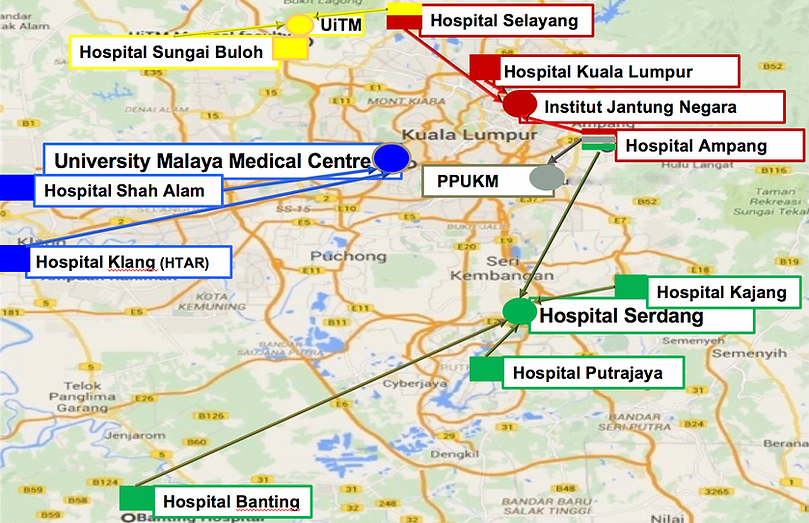top of page


When it comes to the heart, time is of the essence. Once at the hub hospital, the best treatment outcomes are when a patient receives the PCI within 60 minutes (door-to-balloon time), or 120 minutes if the patient is transferred from spoke hospital. The aim is to reduce the total duration of time when the heart is not receiving adequate oxygen (total ischemic time). Since the inception of this network, a 23.4% reduction in the mean door-to-balloon time has been noted in participating hospitals, from 111 minutes to 85 minutes, which leads to better patient care; providing the best care and outcome. The whole goal of primary PCI is to provide revascularization in a timely manner and ultimately translate into improving survival rates.

Angioplasty balloon opening up a clogged blood vessel in the heart

Stent keeping the blood vessel open when the balloon is removed
It is hoped that the success of the pilot project to improve the accessibility of Malaysians to a PCI heart attack can be expanded to the whole of Malaysia in the future. The network system of hospitals is integral to provide a seamless system of care with a 24/7 connectivity.
The MySTEMI Network is a project established by the National Heart Association of Malaysia (NHAM) to provide better access to immediate care for heart attack patients within the Klang Valley. This project was first launched on the 15th of December 2015 and saw its first patient in February 2016. To date, MySTEMI has successfully treated more than 1,000 patients. A hub-and-spoke concept has been adopted for this network, with a total of five hub hospitals and nine spoke centres participating.
MySTEMI Network
If a heart attack patient is admitted to one of these spoke hospitals, he or she will be immediately transferred upon establishing diagnosis of a heart attack to a hub hospital. A hub hospital usually has a cardiac catheterization facility to perform primary percutaneous coronary intervention (PPCI). This treatment involves a minor surgical procedure whereby a thin wire with an expandable balloon tip is inserted into one of the major arteries of the body and is directed into the blocked blood vessel (coronary artery) in the heart. The balloon is then inflated (angioplasty) to open up the blockage and widening the narrowed or occluded artery. A metallic scaffold (stent) is then inserted at the location of the narrowed or occluded in order to restore and maintain adequate blood flow to the heart. This whole procedure takes approximately 30 minutes to 1 hour and have been proven in numerous studies to improve survival rates as well as to reduce long-term morbidity.

Mission
To develop a healthcare facility network for acute coronary syndrome, especially STEMI, from downstream to upstream and to shorten first medical contact to reperfusion for STEMI patients
MySTEMI Network Central Committee
-
Datuk Dr Rosli Mohd Ali (Chairman)
-
Datuk Prof Dr Wan Azman Wan Ahmad
-
Datuk Dr Abd Kahar Abd Ghapar
-
Dr Mahathar Abd Wahab
-
Dr Choo Gim Hooi
-
Dr Mohd Rahal Yusoff (Chair, Data Committee)
-
Tan Sri Dr Robaayah Zambahari (Advisor)
-
YB Datuk Prof Dr Sim Kui Hian (Advisor)
Vision
Reperfusion for all STEMI patients
PCI Video (Hospital Serdang)
MySTEMI Hub Hospitals
-
Institut Jantung Negara
-
Universiti Malaya Medical Centre
-
Hospital Serdang
-
Hospital Universiti Teknologi Mara
-
Pusat Perubatan UKM
-
Hospital Kajang
-
Hospital Selayang
-
Hospital Sungai Buloh
-
Hospital Shah Alam
MySTEMI Spoke Hospitals
-
Hospital Kuala Lumpur (HKL)
-
Hospital Ampang
-
Hospital Tengku Ampuan Rahimah Klang
-
Hospital Putrajaya
-
Hospital Banting


bottom of page
![MyStemi logo 02[1].png](https://static.wixstatic.com/media/062207_9d173ed199ee4192b57faca5f240d56b~mv2_d_3673_2646_s_4_2.png/v1/crop/x_1341,y_876,w_998,h_900/fill/w_105,h_92,al_c,q_85,usm_0.66_1.00_0.01,enc_avif,quality_auto/MyStemi%20logo%2002%5B1%5D.png)




